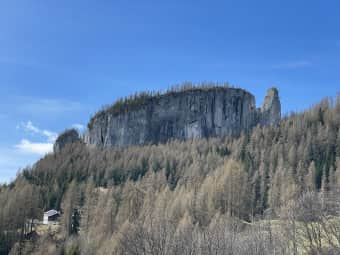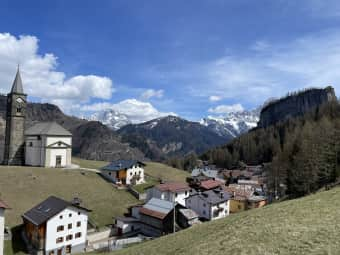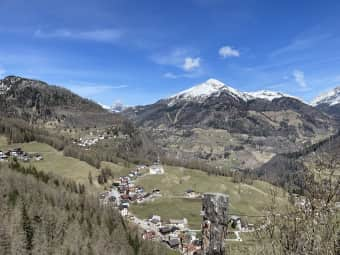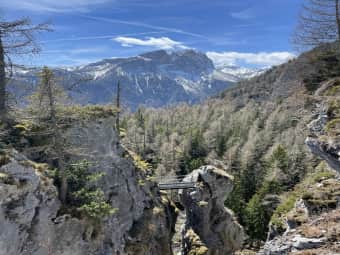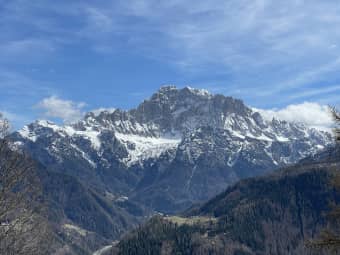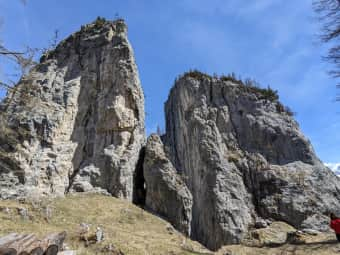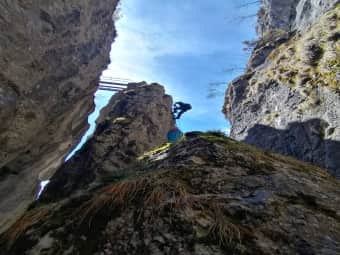It's late April, winter doesn't seem to want to give way to a restless spring yet. Snow continues to fall at high elevations, and the hikes I planned for this season are still inaccessible. It's the perfect time to attempt an unfinished route from late January in Rocca Pietore, or rather, at the Laste di Rocca Pietore and its famous Ronch monoliths. You can find the previous hike with numerous historical details here: From Rocca Pietore to Sass di Ronch
The goal of today's hike is the Sass de Rocia via ferrata, and joining me in today's adventure is the legendary Enrico. Early in the morning, with a blue sky that defies uncertain weather forecasts, we reach the village of Laste di Rocca Pietore. We leave the car in the convenient village parking lot, put on our boots, and head southwest towards the small village of Dagai. We walk along the paved road and, on our left, we begin to see a magnificent panorama from the tip of Mount Pelmo, which peeks out, to Mount Civetta and today's destination: the massive monolith of Sass de Rocia.
Upon arriving in the center of Dagai (Daghèi), we take a small road on the left that climbs alongside the “Small Firefighter's Place”. A little further on, we catch sight of a trail that continues uphill, first through meadows, then following some cut trees. We confidently enter the woods, constantly heading south. We continue through increasingly dense vegetation, and after just about 150 meters of elevation gain, we reach the CAI 636 trail. From here, turning left towards the southeast, we soon glimpse the majestic spire of the first monolith called “Sass de la Gusela” with a cross on the summit. Behind it, almost seeming like the same block, stands the Sas de Rocia.
We reach the first tall and slender monolith that rises with sinuous verticality. Separating the Sass de Rocia is a deep fissure, several tens of meters wide, which can be descended on a rocky path to reach some rock climbing routes or the entrance of the now weather-damaged via ferrata at the base due to the Vaia storm. We skirt the Sass de Rocia, admiring the numerous climbing routes that dot the smooth and vertical rock of the monolith. About halfway up the rocky block, a conspicuous crack opens up, narrow a couple of meters, dark and cramped, from which the via ferrata begins. A clearly visible red sign reminds us to proceed on the route with the proper equipment: helmet, harness, and via ferrata kit.
We prepare ourselves, check each other's equipment, and head into the darkness of the fissure where the metal cable begins immediately. A series of wooden ladders allow us to reach a ladder that overcomes a boulder a couple of meters high. We exit onto a flat area that veers to the left and climbs briefly. From the bend, we can see the old section of the via ferrata, called "Bus del Conicio," which is no longer adequately maintained and descends into the darkness towards the northeast. After the very short curve, we return to the flat, in front of a reassuring Madonna, and a completely vertical rock wall presents itself, with a series of iron rungs that allow reaching the apex a few tens of meters above. I can imagine the excitement for Enrico, on his first via ferrata, starting immediately with such a direct vertical! I start first and Enrico follows me impeccably. At the top there is a short secured traverse up to a second vertical, shorter, which this time ends on a steel bridge. We are suspended about fifty meters from the ground, above a slender spire united by this bridge that whispers metallic sounds with every step. Having reached the other side, we climb, always safely with a cable, on easy rocks up to a panoramic terrace overhanging where you can enjoy a wonderful view of the Pelmo, the Civetta, the White Rock, and the town of Ronch at the base. Once we reach the mugo pines, the area becomes wider and more welcoming. The last part of the via ferrata consists of a new bridge suspended in the void and the arrival on the wide summit head of Sass de Rocia.
Date
22-04-2023
Distance
8.37 KM
Hike type
Trekking
Ascent
388 mt
- Mountain
Monoliti di Ronch
- Address
Laste di Rocca Pietore, Veneto, Italy
- Altitude
1700.00 m
- Refuges
Rifugio Migon
- Information
We leave the equipped stretch and enter a grassy meadow dotted with trees knocked down by Vaia. We proceed on a well-visible path and in 30 minutes from the start of the via ferrata, here we are on the actual summit: the Pian delle Stelle bivouac! A splendid entirely wooden bivouac with an external veranda with two nice tables and adjoining benches. A nice clearing to be able to make a nice fire. There is also a grill for cooking ribs when needed. We are right on the edge of the monolith, only a timid poorly kept wire protects us from the abyss of hundreds of meters separating us from the forest below. From here there is a splendid view of the Col di Lana, the Sass de Stria, the Monte Pore, and the Cernera. The two protagonists of the Dolomites, Pelmo and Civetta, then close the ring. We enjoy the view and a well-deserved break together with some pleasant chats about new via ferratas and Dolomite adventures with two hiker friends found here. We leave the bivouac and, descending the same way up, we retrace the via ferrata paying maximum attention in the descent of the two vertical sections. We finish the route and conclude Enrico's first via ferrata, thrilled with the achievement! Given the speed of the excursion, we try to reach a second goal, the nearby Migon refuge. We remove the via ferrata equipment, take up the CAI 636 path again and go back into the woods until we reach the dirt road that leads from the town of Davare to the refuge. We opt for a straight line across the field. We are welcomed by a dry stone wall that runs along the path we have decided to undertake and accompanies us to the goal. So we arrive at the Migon refuge, with the attached Alpini church. The terrace of the Migon allows you to have a direct view of the beautiful still snow-capped Monte Pore. We descend the drivable road, in the first stretch still abundantly snow-covered. At the first bend, it is possible to find a track that leads directly to Rocca Pietore and Caprile. In a short time, we arrive at the town of Davare where we see the beautiful Col di Lana again. Just past the village, we turn right onto a shortcut through the woods that descends towards Dagai. Once we arrive on a grassy meadow, we find ourselves in front of a splendid postcard with the rural village and the beautiful little church that evoke a distant memory of times gone by. We return to the main road that takes us back to the morning's parking lot. Thus concludes a wonderful adventure to the monoliths of Ronch, to the via ferrata of Sass de Rocia at the Laste of Rocca Pietore. The via ferrata is very simple, short, and every step is made safely. The return backward and the initial verticality, even if for a few meters, could bother the novice lovers of via ferratas. Overall, it's an easy route suitable for adults and even the youngest ones. A quick excursion that can be done in half a day but with a great emotional impact given the splendid views and the types of attractions that the area of the imposing monoliths offers.
DifficultyHikers - Itineraries on paths or evident traces in various types of terrain (pastures, debris, stony ground ...). They are generally marked with paint or cairns (pyramid-shaped stacked stones that allow you to identify the route even from a distance). They can also take place in snowy but only slightly inclined environments. They require the equipment described in the part dedicated to hiking and sufficient orientation skills, walking training for a few hours. |
